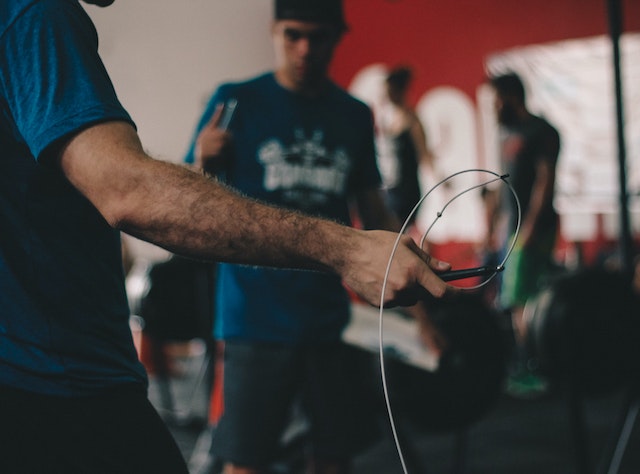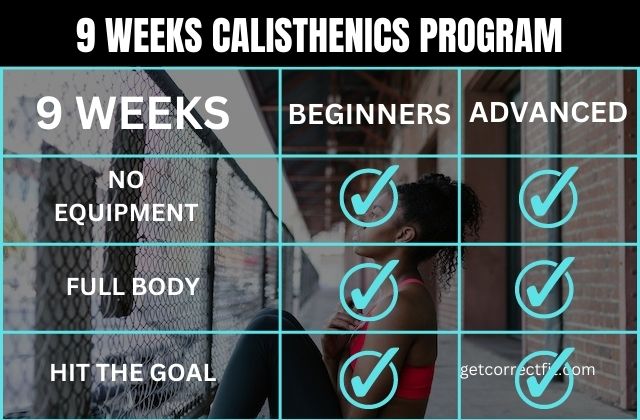Plyometric training is one of the activities that challenges your fitness and helps you build an athletic body and cardiovascular endurance because it is based on cardio and speed exercises.
These workouts are suitable for people who want to improve strength and speed, and even weight loss, as these workouts include a group of exercises that raise the heart rate and burn a lot of calories during each session.
So if you are ready to show off your athletic performance and improve your fitness then you are in the right place, Plyo workouts will help you unlock your explosive power in just 4 weeks.
The good thing with this workout that you get is that it is suitable for all fitness levels because it is adjustable and I will reveal to you how to increase or decrease the intensity of the exercises according to your fitness level, so whether you are a beginner or a professional, this will be well suited for you.
In this post, you will learn about your comprehensive guide to starting 4 weeks of plyometric training, the exercises that you will do during each session, sets and reps, rest periods, some techniques to avoid injury and recover quickly, how to increase the intensity of exercises, and so on.
Let’s jump together!
What is plyometric training?
This is a simple definition directed to people who are ignorant of what these exercises are. If you are aware of them, you can jump to the place of the exercises.
Plyometric training, also known as jump training or plyos, is a type of exercise that focuses on explosive movements to improve strength, speed, and athletic performance. Incorporating quick intense muscle contraction, and using the stretch shortening cycle, causes the muscle to stretch rapidly before contracting with full force.
Plyo exercises, which usually include jumping, hopping, pounding, and throwing movements, aim to increase the muscle’s ability to produce maximum force in the least amount of time.

Who can follow a plyometric training program?
Plyo exercises are more useful for athletes who are integrated with different activities that require explosive movements, speed of movements and high jumps. Here we are talking about football players, basketball, handball and similar activities.
But this does not mean that it is limited to athletes only, but anyone can do plyo training as long as he respects your fitness limits and trains safely, so you too can get the same benefits that athletes get and develop your fitness tremendously.
Read A Professional Article : Plyometric Training Program – Effects, Risks
4 Week Plyometric Training Program For Max Explosive Power Enhances
Plyometric Training Guidance
| LEVELS | SETS | REST TIMES | SESSIONS PER WEEK |
|---|---|---|---|
| Beginners | 1-2 Sets | 1-2 min between rounds | 2-3 Times |
| Intermediate | 2-3 Sets | 1-2 min between rounds | 3-4 Times |
| Advanced | 3-4 Sets | 1-2 min between rounds | 4-5 Times |
Week 1:
Monday Session 1: 3 Circuits
Warm-up (5 minutes of light cardio), followed by the following circuit:
| CIRCUIT 1 | CIRCUIT 2 | CIRCUIT 3 |
|---|---|---|
| Box Jumps: 8 reps | Standing Long Jumps: 6 reps | Box Jumps: 8 reps |
| Medicine Ball Slams: 10 reps | Tuck Jumps: 8 reps | Depth Jumps: 6 reps |
| Depth Jumps: 6 reps | Lateral Bounds: 12 reps per side | Single-Leg Bounds: 8 reps per leg |
| Plyometric Push-ups: 10 reps | Squat Jumps: 10 reps | Plyometric Push-ups: 10 reps |

Wednesday Session 2: 3 Circuits
Warm-up (5 minutes of light cardio), followed by the following circuit:
| CIRCUIT 1 | CIRCUIT 2 | CIRCUIT 3 |
|---|---|---|
| Box Jumps: 8 reps | Squat Jumps: 10 reps | Box Jumps: 8 reps |
| Depth Jumps: 6 reps | Lateral Bounds:12 reps per side | Tuck Jumps: 8 reps |
| Single-Leg Bounds: 8 reps per leg | Depth Jumps: 6 reps | Standing Long 6 reps |
| Plyometric Push-ups:10 reps | Plyometric Lunges: 10 reps per leg | Plyometric Push-ups: 10 reps |
Friday Session 3: 3 Circuits
Warm-up (5 minutes of light cardio), followed by the following circuit:
| CIRCUIT 1 | CIRCUIT 2 | CIRCUIT 3 |
|---|---|---|
| Depth Jumps: 6 reps | Lateral Bounds: 12 reps per leg | Plyometric Push-ups: 10 reps |
| Single-Leg Bounds: 8 reps per leg | Broad Jumps: 10 reps | Split Jumps: 10 reps per leg |
| Medicine Ball Slams:10 reps | Skater Hops: 15 reps per leg | Depth Jumps: 6 reps |
| Plyometric Lunges: 10 reps per leg | Plyometric Lunges: 10 reps per leg | Single-Leg Bounds: 8 reps per leg |
Week 2:
Monday Session 1: 3 Circuits
Warm-up (5 minutes of light cardio), followed by the following circuit:
| CIRCUIT 1 | CIRCUIT 2 | CIRCUIT 3 |
|---|---|---|
| Squat Jumps: 10 reps | Lateral Bounds: 12 reps per side | Depth Jumps: 6 reps |
| Depth Jumps: 6 reps | Tuck Jumps: 3 sets of 8 reps | Standing Long Jumps: 6 reps |
| Plyometric Push-ups: 10 reps | Medicine Ball Slams: 10 reps | Plyometric Lunges: 10 reps per leg |
| Box Jumps: 8 reps | Single-Leg Bounds: 8 reps per leg | Plyometric Push-ups: 10 reps |

Wednesday Session 2: 3 Circuits
Warm-up (5 minutes of light cardio), followed by the following circuit:
| CIRCUIT 1 | CIRCUIT 2 | CIRCUIT 3 |
|---|---|---|
| Squat Jumps: 10 reps | Box Jumps: 8 reps | Depth Jumps: 6 reps |
| Lateral Bounds: 12 reps per side | Standing Long Jumps: 6 reps | Single-Leg Bounds: 8 reps per leg |
| Depth Jumps: 6 reps | Plyometric Push-ups: 10 reps | Medicine Ball Slams: 10 reps |
| Plyometric Lunges: 10 reps per leg | Tuck Jumps: 8 reps | Plyometric Lunges: 10 reps per leg |
Friday Session 3: 4 Circuits
Warm-up (5 minutes of light cardio), followed by the following circuit:
| CIRCUIT 1 | CIRCUIT 2 | CIRCUIT 3 | CIRCUIT 4 |
|---|---|---|---|
| Squat Jumps: 10 reps | Medicine Ball Slams: 10 reps | Standing Long Jumps: 6 reps | Single-Leg Bounds: 8 reps per leg |
| Depth Jumps: 6 reps | Box Jumps: 8 reps | Plyometric Lunges: 10 reps per leg | Tuck Jumps: 8 reps |
| Split Jumps: 10 reps per leg | Lateral Bounds: 12 reps per side | Depth Jumps: 6 reps | Plyometric Push-ups: 10 reps |

Week 3:
Monday Session 1: 3 Circuits
Warm-up (5 minutes of light cardio), followed by the following circuit:
| CIRCUIT 1 | CIRCUIT 2 | CIRCUIT 3 |
|---|---|---|
| Depth Jumps: 8 reps | Box Jumps: 10 reps | Plyometric Lunges: 12 reps per leg |
| Split Jumps: 12 reps per leg | Lateral Bounds: 15 reps per side | Standing Long Jumps: 8 reps |
| Medicine Ball Slams: 12 reps | Tuck Jumps: 10 reps | Single-Leg Bounds: 10 reps per leg |
| Plyometric Push-ups: 12 reps | Squat Jumps: 12 reps | Depth Jumps: 8 reps |
Wednesday Session 2: 3 Circuits
Warm-up (5 minutes of light cardio), followed by the following circuit:
| CIRCUIT 1 | CIRCUIT 2 | CIRCUIT 3 |
|---|---|---|
| Depth Jumps: 10 reps | Box Jumps: 12 reps | Plyometric Lunges: 15 reps per leg |
| Split Jumps: 15 reps per leg | Lateral Bounds: 18 reps per side | Standing Long Jumps: 10 reps |
| Medicine Ball Slams: 15 reps | Tuck Jumps: 12 reps | Single-Leg Bounds: 12 reps per leg |
| Plyometric Push-ups: 15 reps | Squat Jumps: 15 reps | Depth Jumps: 10 reps |
Friday Session 3: 4 Circuits
Warm-up (5 minutes of light cardio), followed by the following circuit:
| CIRCUIT 1 | CIRCUIT 2 | CIRCUIT 3 | CIRCUIT 4 |
|---|---|---|---|
| Depth Jumps: 12 reps | Plyometric Push-ups: 18 reps | Tuck Jumps: 15 reps | Standing Long Jumps: 12 reps |
| Split Jumps: 20 reps per leg | Box Jumps: 15 reps | Squat Jumps: 18 reps | Single-Leg Bounds: 15 reps per leg |
| Medicine Ball Slams: 18 reps | Lateral Bounds: 20 reps per side | Plyometric Lunges: 18 reps per leg | Depth Jumps: 12 reps |

Week 4:
Monday Session 1: 3 Circuits
Warm-up (5 minutes of light cardio), followed by the following circuit:
| CIRCUIT 1 | CIRCUIT 2 | CIRCUIT 3 |
|---|---|---|
| Squat Jumps: 12 reps | Broad Jumps: 10 reps | Single-Leg Vertical Jumps: 10 reps per leg |
| Box Jumps: 10 reps | Skater Hops: 15 reps per leg | Squat Jumps: 15 reps |
| Tuck Jumps: 15 reps | Lateral Bounds: 12 reps per leg | Box Jumps: 12 reps |
| Split Squat Jumps: 12 reps per leg | Depth Jumps: 8 reps | Tuck Jumps: 18 reps |
Wednesday Session 2: 4 Circuits
Warm-up (5 minutes of light cardio), followed by the following circuit:
| CIRCUIT 1 | CIRCUIT 2 | CIRCUIT 3 | CIRCUIT 4 |
|---|---|---|---|
| Split Squat Jumps: 15 reps per leg | Lateral Bounds: 15 reps per leg | Squat Jumps: 18 reps | Skater Hops: 20 reps per leg |
| Broad Jumps: 12 reps | Depth Jumps: 10 reps | Box Jumps: 15 reps | Broad Jumps: 15 reps |
| Skater Hops: 18 reps per leg | Single-Leg Vertical Jumps: 12 reps per leg | Tuck Jumps: 20 reps | Split Squat Jumps: 18 reps per leg |
Friday Session 3: 4 Circuits
Warm-up (5 minutes of light cardio), followed by the following circuit:
| CIRCUIT 1 | CIRCUIT 2 | CIRCUIT 3 | CIRCUIT 4 |
|---|---|---|---|
| Lateral Bounds: 18 reps per leg | Tuck Jumps: 22 reps | Split Squat Jumps: 20 reps per leg | Single-Leg Vertical Jumps: 18 reps per leg |
| Depth Jumps: 12 reps | Squat Jumps: 20 reps | Broad Jumps: 18 reps | Depth Jumps: 15 reps |
| Single-Leg Vertical Jumps: 15 reps per leg | Box Jumps: 18 reps | Skater Hops: 22 reps per leg | Lateral Bounds: 20 reps per leg |
Proper Form Technique
Remember to always prioritize proper form and technique during the exercises. Start with a weight and intensity that is suitable for your fitness level and gradually increase as you progress. Rest and recovery are equally important, so listen to your body and give it time to recover between sessions. Enjoy your plyometric training journey and see the improvements in your explosive power!
To Progress With Plyos Training
As the weeks progress, the intensity and volume of the exercises increase to continually challenge your explosive power. Remember to focus on proper form and technique for each exercise to maximize effectiveness and reduce the risk of injury. Adjust the repetitions and rest periods based on your fitness level and gradually increase the difficulty as you progress. Stay consistent with your training, and you’ll notice improvements in your explosive power over the course of the 4-week program.
Plyometric Training Program-Warm Up
Remember to warm up before each session and cool down afterward. Focus on proper form and technique for each exercise to maximize your explosive power gains. As you progress through the program, challenge yourself by increasing the intensity, speed, or height of the jumps.
Additional Tips
Additionally, ensure you have adequate rest days between sessions to allow your muscles to recover and adapt. Listen to your body and modify the exercises or repetitions if needed to accommodate your fitness level.
Keep pushing yourself, stay consistent, and track your progress throughout the program. With dedication and effort, you’ll be on your way to improving your explosive power and reaching your fitness goals.
Note: It’s always recommended to consult with a qualified fitness professional or trainer before starting any new exercise program, especially if you have any underlying health conditions or concerns.
FAQ
Who can benefit from a plyometric training program?
Plyometric training can benefit athletes, fitness enthusiasts, and individuals looking to enhance their power, speed, and overall athletic performance.
How often should I do plyometric training?
It’s always recommended to incorporate plyo training into your routine 1 – 3 times per week for beginners, allowing for adequate rest and recovery between sessions.
Are plyometric exercises safe?
When you maintain proper form and do what you are capable of i.e. respecting your fitness limits, plyometric training is generally safe. But it is necessary to start with an easy program that is in line with your fitness level, and then increase the intensity as your performance develops.
Do I need any special for plyometric training?
Plyometric exercises usually do not require much equipment so most can be done without equipment, but some exercises may require some equipment such as a plyo box, medicine ball, or resistance bands, in order to add some intensity to your training.
Can plyometric training help with weight loss?
Yes, of course, plyometric exercises can significantly contribute to weight loss, because they are designed to raise heart rate, burn calories in various areas of the body, and help sculpt muscles.
Try to combine it with a good rounded fitness and nutritional program for impressive results
Related Posts
6 Week hypertrophy workout plan for muscle gain
4 Week plan for total body transformation with resistance bands
Try the best kettlebell workout plan for full body fitness at home



